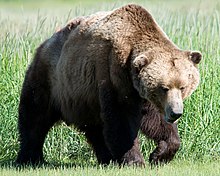| Alaska Peninsula brown bear Temporal range: Late Pleistocene – Recent
| |
|---|---|

| |
| Brown bear in Hallo Bay, Katmai National Park, Alaska, US | |
| Scientific classification | |
| Domain: | Eukaryota |
| Kingdom: | Animalia |
| Phylum: | Chordata |
| Class: | Mammalia |
| Order: | Carnivora |
| Family: | Ursidae |
| Genus: | Ursus |
| Species: | |
| Subspecies: | U. a. gyas
|
| Trinomial name | |
| Ursus arctos gyas | |
The Alaska Peninsula brown bear (Ursus arctos gyas) or "peninsular grizzly" is a colloquial nomenclature for a possible brown bear subspecies that lives in the coastal regions of southern Alaska. It may be a population of the mainland grizzly bear subspecies (Ursus arctos horribilis).[3]
Alaska Peninsula brown bears are very large, usually ranging in weight from 800 to 1,200 lb (360 to 540 kg).[5] They are found in high densities along the southern Alaskan coast due not only to the large amount of clams and sedge grass but also to the annual salmon runs; this allows them to attain huge sizes, some of the biggest in the world.[6] They may gather in large numbers at feeding sites, such as Brooks Falls and McNeil Falls, both in Katmai National Park near King Salmon. Biologists maintain that coastal ones are truly brown bears. However, it is considered correct to place all North American members of U. arctos in the subspecies horribilis except the giant Kodiak bears of Kodiak Island.[7] To avoid confusion, many simply refer to all North American members, including Kodiaks, as "brown bears".
Prized by hunters for their skulls and hides, up to 500 of Alaska's 1,500 brown bears killed yearly by hunters come from the Alaska Peninsula. To hunt this large bear, hunters must follow a variety of regulations, including bear bag limits, hunting fees and proper rifles.[8]
- ^ "Ursus arctos". explorer.natureserve.org.
Alaska=S4
- ^ "Ursus arctos gyas Merriam, 1902". ITIS.
- ^ a b "Brown Bear". Alaska Department of Fish and Game.
- ^ Burt, Henry W. (1952), A Field Guide to the Mammals, p. 42
- ^ Whitaker, John O. (1980), The Audubon Society Field Guide to North American Mammals, Knopf, ISBN 0-394-50762-2
- ^ "Mammalian Species- Ursus arctos" (PDF). American Society of Mammalogists, Smith College. Archived from the original (PDF) on March 4, 2016. Retrieved June 14, 2012.
- ^ "Brown or Grizzly Bear". North American Bear Center. Archived from the original on August 29, 2015. Retrieved May 1, 2014.
- ^ "Brown Bear Research in Alaska". ADFG.
